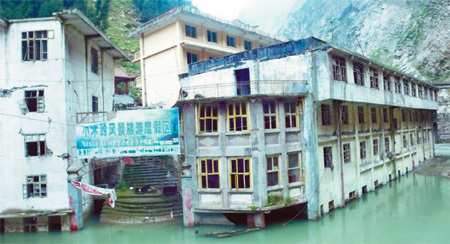Wang Hua, 30, lost her seven-year-old daughter in last year's Sichuan earthquake. Now, one year on, she is looking forward to the arrival of another child. But Wang's hopes for the future are clouded by fears for the safety of her family.
|

|
|
Xiaomuling Holiday Resort in the mountainous region of Sichuan's Mianzhu city was badly damaged by the quake and landslides. Many farmers in the quake zone are still threatened by possible floods and mudslides. File photo |
Wang still lives in a hamlet of seven families 5 km from the town of Nanba, which was razed to the ground in the May 12 quake.
The small community sits on land only 40 m above a fast-flowing river that swells during the rains and against the backdrop of a slope formed by a landslide from the nearby mountains.
"I am quite concerned about our safety, particularly the safety of the baby that's on the way. The rainy season is coming and it's very dangerous. I am afraid a mudslide may kill us," said Wang.
Mudslides are always a concern in the rainy season for Wang and her fellow villagers. "For us, changing this dangerous situation is more urgent than anything else," said Wang, adding that poverty has forced the families to stay put.
Wang's community is typical of the rural settlements along a 1,000-km semicircular scenic route that evolved from the northeast and northwest paths leading to the Jiuzhaigou World Heritage Site from Chengdu, the capital of Sichuan province.
Located between the Sichuan Basin and the Qinghai-Tibet Plateau, the area's altitude rises from 500 m to 4,500 m over a distance of 200 km. The region's vegetation ranges from primary forest to meadows, endowing the area with many kinds of plants amid mountains and waterways.
Before the quake, this bow-shaped road and its backdrop of picturesque mountains, meandering rivers and fascinating historical relics attracted millions of domestic and international tourists annually and became an important source of income for the poverty-stricken locals.
However, after the quake, once green mountains are now scarred and covered in dust, sand and rocks. Boulders hang so precariously that passers-by choke back coughs and sneezes for fear of triggering a landslide, while rivers are blocked, and buildings designated as historic relics lie in ruins.
About 430,000 hectares of forest has been crushed by land and mudslides triggered by the earthquake and its aftershocks, while around 1,000 reservoirs in the province have been damaged.
Around 8,000 sites in Sichuan face the threat of geological disasters resulting from the quake, threatening up to 640,000 people
Song Guangqi, director of Sichuan provincial land and resources department, said that the province would spend 11.4 billion yuan on the restoration of sites threatened by geological disasters or on relocating residents facing these risks.
After completing the restoration of 2,300 disaster sites, about one-eighth of households, or 18,000, would be relocated in the coming two years to avoid geological disasters, said Song.
The effect of potential geological disasters triggered by the quake would last for ten years, he added.
Abnormal weather
Sichuan is about three times the size of the United Kingdom and borders the Qinghai-Tibet Plateau. The Sichuan Basin has been called a "cold center" by the Ministry of Science and Technology, even though the Earth's surface temperature has increased by about 0.6 degrees over the past century.
But that doesn't mean Sichuan province is a climate-change-free zone. Instead, extreme weather events such as a scorching drought in 2006 and devastating flash floods in 2007 have made climate change a life-or-death matter for residents, especially for millions of poor people and local farmers.
The China Meteorological Administration (CMA) recently warned that last winter and spring's drought may result in major flooding this summer. If the warning comes true, earthquake survivors in mountainous areas may suffer from downpours, floods and massive landslides unless effective precautions are taken.
The reason is quite simple: the mountains have already been rocked and softened.
And, as a result of the quake, Sichuan's forest coverage rate has dropped by one percentage point to 27 percent.
Responding to the urgency, the CMA has channeled about 520 million yuan to rebuild meteorological facilities in areas devastated by the earthquake. In mid-May, Vice-Minister of Water Resources Jiao Yong visited Sichuan and asked the provincial government to be prepared to fight massive floods, especially to prevent the leakage of damaged reservoirs.
Of late, it has been continuously raining in parts of Sichuan. The prolonged rains have made Wang Hua and the other locals stay together as stones and mud fall from the steep slopes onto their homes.
"That is all we can do now," said Wang. "By staying together will we feel less fearful."
(China Daily June 1, 2009)